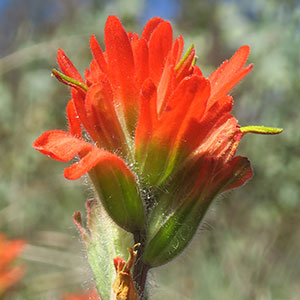Castilleja glandulifera
Castilleja brevilobata
gland Indian paintbrush, glandular paintbrush, sticky paintbrush
short-lobed paintbrush
few to many, erect or ascending, sometimes decumbent, unbranched or often branched proximally, hairs spreading, medium length and long, soft, mixed with more abundant stipitate-glandular ones.
solitary or few, erect or ascending, unbranched, sometimes branched, hairs spreading, short, medium, and long, soft, short and medium ones short stipitate-glandular.
green, linear-lanceolate to sometimes narrowly oblong or narrowly oblanceolate, 0.7–3.7 cm, not fleshy, margins wavy, involute, 0(–5)-lobed, apex acute;
lateral lobes ascending to erect, narrowly lanceolate to narrowly oblong, usually narrower than center lobe, apex acute.
green or ± yellow, lanceolate, elliptic, or oblong to narrowly ovate, 1–2(–2.5) cm, not fleshy, margins plane or wavy, involute, (0–)3–5(–7)-lobed, apex rounded to acute;
lobes ascending to erect, linear to lanceolate, apex rounded to acute.
2.5–10 × 2–5 cm;
bracts proximally pale green to pale yellow, distally yellow, whitish, pink, dull red, or purple on apices (sometimes gradually differentiated from proximal coloration), lanceolate, broadly lanceolate, or oblong, 3–5(–7)-lobed, sometimes with secondary lobes;
lobes ascending to spreading, linear, sometimes rounded, medium length or distal short, arising near mid length, apex acute to rarely obtuse.
3–20 × 2–3.5 cm;
bracts proximally greenish to dull brown, distally red, orange-red, or scarlet, sometimes orange or yellow, broadly lanceolate or oblong, (0–)3–5-lobed;
lobes ascending, broadly to narrowly lanceolate, short, arising above mid length, apex acute, obtuse, or rounded.
straight or slightly curved, (20–)22–30 mm;
tube 15 mm;
abaxial lip usually hidden or just visible in abaxial calyx notch, not exserted/longer than calyx, beak exserted;
beak straight or slightly curved, adaxially green, 8–11(–12) mm;
abaxial lip deep green to yellow, reduced, slightly pouched, 1–2.5 mm, to 20% as long as beak;
teeth incurved, green to yellow, 0.5–1 mm.
straight, 15–24(–26) mm;
tube 12–16 mm;
beak exserted, abaxial lip equal to calyx;
beak adaxially green or ± yellow-green, 7–10 mm, puberulent, stipitate-glandular;
abaxial lip deep green, reduced, rounded, 1–2 mm, 10–25% as long as beak;
teeth incurved to erect, light green, 0.5–1 mm.
proximally green or pale, distally colored as bracts, 17–21(–23) mm;
abaxial and adaxial clefts 4–8 mm, 33–50% of calyx length, deeper than laterals, lateral 2–6 mm, 15–33% of calyx length;
lobes linear, narrowly lanceolate, or narrowly triangular to oblong, apex acute.
green or whitish with green veins, lobes colored as bract lobes or paler, 14–30 mm;
abaxial and adaxial clefts 5.5–8.5 mm, 30–40% of calyx length, deeper than laterals, lateral 1.5–4 mm, 20–25% of calyx length;
lobes oblong to narrowly triangular, apex obtuse to rounded.
= 24.
Castilleja glandulifera
Castilleja brevilobata
Castilleja glandulifera is endemic to the upper elevations of the Blue and Strawberry mountains of northeastern Oregon, as well as a few adjacent minor ranges. It is related to C. applegatei and C. viscidula, which are the source of reports of C. glandulifera in the Wallowa Mountains and on Steens Mountain. Inflorescences of C. glandulifera are usually white to pale yellow, but in the area around Marble Creek Pass in Baker County, they are multicolored, with a variety of reddish shades mixed in among the yellowish plants. Castilleja glandulifera and C. viscidula share a glandular pubescence, divided leaves, and usually yellowish inflorescences. Castilleja glandulifera is distinguished from C. viscidula by its taller stature, longer corolla beak, and more deeply divided leaves and bracts with linear to linear-lanceolate lobes. Castilleja glandulifera differs from C. applegatei by its unusual leaves and bracts as well as by its habitat and narrower and somewhat shorter corolla beak.
(Discussion copyrighted by Flora of North America; reprinted with permission.)
Castilleja brevilobata is endemic to dry serpentine openings in the Siskiyou Mountains of southwestern Oregon and adjacent California. Although sometimes treated as part of C. applegatei or C. hispida, its morphology does not suggest a close connection with either. This species occasionally hybridizes with C. pruinosa in Del Norte County, California.
(Discussion copyrighted by Flora of North America; reprinted with permission.)


